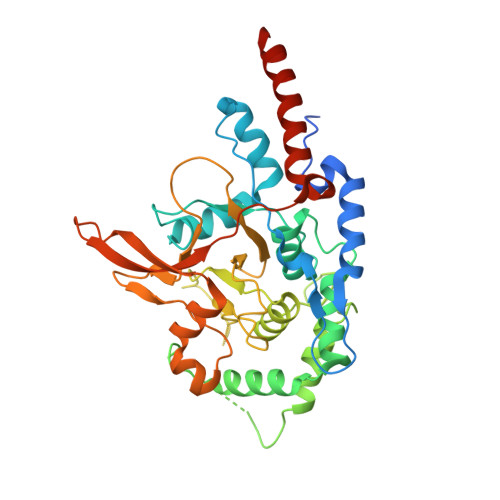Molecular basis for the unique deubiquitinating activity of the NF-kappaB inhibitor A20
Lin, S.-C., Chung, J.Y., Lamothe, B., Rajashankar, K., Lu, M., Lo, Y.-C., Lam, A.Y., Darnay, B.G., Wu, H.(2008) J Mol Biology 376: 526-540
- PubMed: 18164316
- DOI: https://doi.org/10.1016/j.jmb.2007.11.092
- Primary Citation of Related Structures:
3DKB - PubMed Abstract:
Nuclear factor kappaB (NF-kappaB) activation in tumor necrosis factor, interleukin-1, and Toll-like receptor pathways requires Lys63-linked nondegradative polyubiquitination. A20 is a specific feedback inhibitor of NF-kappaB activation in these pathways that possesses dual ubiquitin-editing functions. While the N-terminal domain of A20 is a deubiquitinating enzyme (DUB) for Lys63-linked polyubiquitinated signaling mediators such as TRAF6 and RIP, its C-terminal domain is a ubiquitin ligase (E3) for Lys48-linked degradative polyubiquitination of the same substrates. To elucidate the molecular basis for the DUB activity of A20, we determined its crystal structure and performed a series of biochemical and cell biological studies. The structure reveals the potential catalytic mechanism of A20, which may be significantly different from papain-like cysteine proteases. Ubiquitin can be docked onto a conserved A20 surface; this interaction exhibits charge complementarity and no steric clash. Surprisingly, A20 does not have specificity for Lys63-linked polyubiquitin chains. Instead, it effectively removes Lys63-linked polyubiquitin chains from TRAF6 without dissembling the chains themselves. Our studies suggest that A20 does not act as a general DUB but has the specificity for particular polyubiquitinated substrates to assure its fidelity in regulating NF-kappaB activation in the tumor necrosis factor, interleukin-1, and Toll-like receptor pathways.
- Department of Biochemistry, Weill Medical College of Cornell University, 1300 York Avenue, New York, NY 10021, USA.
Organizational Affiliation:
















